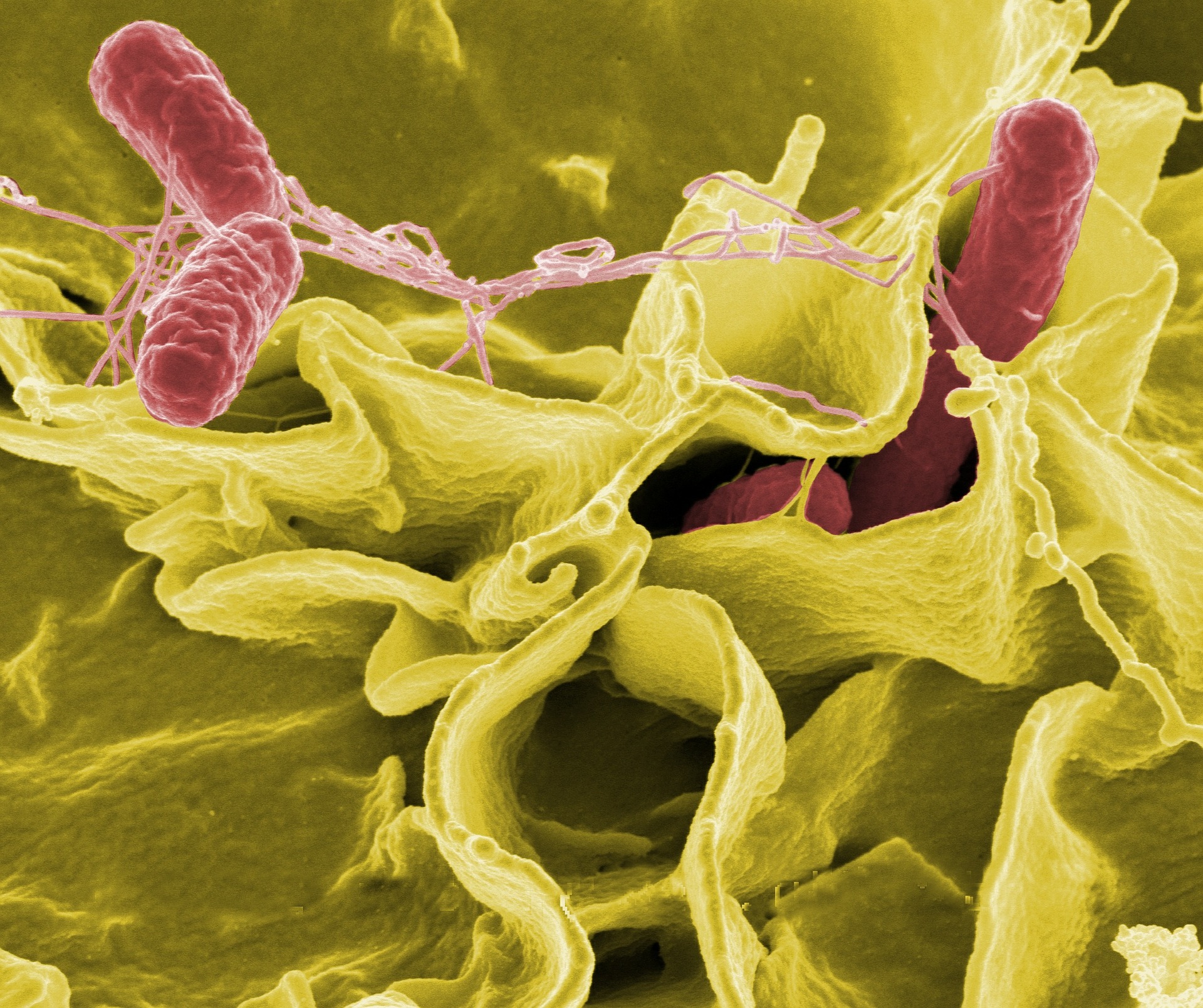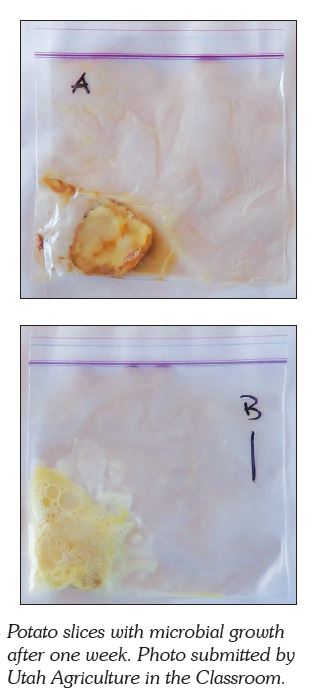Microbes – They're Everywhere!
Students will explore the varied roles that microorganisms play in the world as well as different methods for controlling their growth. Activities include using a dichotomous key to identify waterborne diseases, comparing effectiveness of handwashing techniques, reading fictional and factual excerpts about microbes, and experimenting with the growth of microorganisms on potato slices.
Background
Lesson Activities
Recommended Companion Resources
Credits
Author
Debra Spielmaker | Utah Agriculture in the Classroom
Standards
Texas Content Area Standards
-
Principles of Agriculture, Food, and Natural Resources: 130.2.c.1
The student demonstrates professional standards/employability skills as required by business and industry. The student is expected to:
- Principles of Agriculture, Food, and Natural Resources: 130.2.c.1.B: apply competencies related to resources, information, interpersonal skills, problem solving, critical thinking, and systems of operation in agriculture, food, and natural resources.
- Principles of Agriculture, Food, and Natural Resources: 130.2.c.1.C: demonstrate knowledge of personal and occupational safety, environmental regulations, and first-aid policy in the workplace.
- Principles of Agriculture, Food, and Natural Resources: 130.2.c.1.D: analyze employers' expectations such as appropriate work habits, ethical conduct, legal responsibilities, and good citizenship skills.
-
Principles of Agriculture, Food, and Natural Resources: 130.2.c.6
The student demonstrates appropriate personal and communication skills. The student is expected to:
- Principles of Agriculture, Food, and Natural Resources: 130.2.c.6.A: demonstrate written and oral communication skills appropriate for formal and informal situations such as prepared and extemporaneous presentations.
- Principles of Agriculture, Food, and Natural Resources: 130.2.c.6.B: demonstrate effective listening skills appropriate for formal and informal situations.
-
Principles of Agriculture, Food, and Natural Resources: 130.2.c.7
The student applies appropriate research methods to agriculture, food, and natural resources topics. The student is expected to:
- Principles of Agriculture, Food, and Natural Resources: 130.2.c.7.B: use a variety of resources for research and development.
- Principles of Agriculture, Food, and Natural Resources: 130.2.c.7.C: describe scientific methods of research.
- Principles of Agricultures, Food, and Natural Resources: 130.2.c.7.A: discuss major research and developments in the fields of agriculture, food, and natural resources.
-
ELA: 6.110.22.b.1
Developing and sustaining foundational language skills: listening, speaking, discussion, and thinking- oral language. The student develops oral language through listening, speaking, and discussion.
- ELA: 6.1.B: The student is expected to follow and give oral instructions that include multiple action steps.
- ELA: 6.1.D: The student is expected to participate in student-led discussions by eliciting and considering suggestions from other group members, taking notes, and identifying points of agreement and disagreement.
-
ELA: 6.110.22.b.3
Developing and sustaining foundational language skills: listening, speaking, reading, writing, and thinking--fluency. The student reads grade-level text with fluency and comprehension. The student is expected to adjust fluency when reading grade-level text based on the reading purpose.
- ELA: 6.b.3: Developing and sustaining foundational language skills: listening, speaking, reading, writing, and thinking--fluency. The student reads grade-level text with fluency and comprehension. The student is expected to adjust fluency when reading grade-level text based on the reading purpose.
-
ELA: 6.110.22.b.5
Comprehension skills: listening, speaking, reading, writing, and thinking using multiple texts. The student uses metacognitive skills to both develop and deepen comprehension of increasingly complex texts.
- ELA: 6.5.G: The student is expected to evaluate details read to determine key ideas.
- ELA: 6.5.H: The student is expected to synthesize information to create new understanding.
-
ELA: 6.110.22.b.12
Inquiry and research: listening, speaking, reading, writing, and thinking using multiple texts. The student engages in both short-term and sustained recursive inquiry processes for a variety of purposes.
- ELA: 6.12.A: The student is expected to generate student-selected and teacher-guided questions for formal and informal inquiry.
- ELA: 6.12.D: The student is expected to identify and gather relevant information from a variety of sources.
- ELA: 6.12.F: The student is expected to synthesize information from a variety of sources.
- ELA: 6.12.J: use an appropriate mode of delivery, whether written, oral, or multimodal, to present results.
-
ELA: 7.110.23.b.1
Developing and sustaining foundational language skills: listening, speaking, discussion, and thinking- oral language. The student develops oral language through listening, speaking, and discussion.
- ELA: 7.1.B: The student is expected to follow and give complex oral instructions to perform specific tasks, answer questions, or solve problems.
- ELA: 7.1.D: The student is expected to engage in meaningful discourse and provide and accept constructive feedback from others.
-
ELA: 7.110.23.b.3
Developing and sustaining foundational language skills: listening, speaking, reading, writing, and thinking--fluency. The student reads grade-level text with fluency and comprehension. The student is expected to adjust fluency when reading grade-level text based on the reading purpose.
- ELA: 7.b.3: Developing and sustaining foundational language skills: listening, speaking, reading, writing, and thinking--fluency. The student reads grade-level text with fluency and comprehension. The student is expected to adjust fluency when reading grade-level text based on the reading purpose.
-
ELA: 7.110.23.b.5
Comprehension skills: listening, speaking, reading, writing, and thinking using multiple texts. The student uses metacognitive skills to both develop and deepen comprehension of increasingly complex texts.
- ELA: 7.5.G: The student is expected to evaluate details read to determine key ideas.
- ELA: 7.5.H: The student is expected to synthesize information to create new understanding.
-
ELA: 7.110.23.b.12
Inquiry and research: listening, speaking, reading, writing, and thinking using multiple texts. The student engages in both short-term and sustained recursive inquiry processes for a variety of purposes.
- ELA: 7.12.A: The student is expected to generate student-selected and teacher-guided questions for formal and informal inquiry.
- ELA: 7.12.D: The student is expected to identify and gather relevant information from a variety of sources.
- ELA: 7.12.F: The student is expected to synthesize information from a variety of sources.
- ELA: 7.12.J: The student is expected to use an appropriate mode of delivery, whether written, oral, or multimodal, to present results.
-
ELA: 8.110.24.b.1
Developing and sustaining foundational language skills: listening, speaking, discussion, and thinking- oral language. The student develops oral language through listening, speaking, and discussion.
- ELA: 8.1.B: The student is expected to follow and give complex oral instructions to perform specific tasks, answer questions, or solve problems.
- ELA: 8.1.D: The student is expected to participate collaboratively in discussions, plant agendas with clear goals and deadlines, set time limits for speakers, take notes, and vote on key issues.
-
ELA: 8.110.24.b.3
Developing and sustaining foundational language skills: listening, speaking, reading, writing, and thinking--fluency. The student reads grade-level text with fluency and comprehension. The student is expected to adjust fluency when reading grade-level text based on the reading purpose.
- ELA: 8.b.3: Developing and sustaining foundational language skills: listening, speaking, reading, writing, and thinking--fluency. The student reads grade-level text with fluency and comprehension. The student is expected to adjust fluency when reading grade-level text based on the reading purpose.
-
ELA: 8.110.24.b.5
Comprehension skills: listening, speaking, reading, writing, and thinking using multiple texts. The student uses metacognitive skills to both develop and deepen comprehension of increasingly complex texts.
- ELA: 8.5.G: The student is expected to evaluate details read to determine key ideas.
- ELA: 8.5.H: The student is expected to synthesize information to create new understanding.
-
ELA: 8.110.24.b.12
Inquiry and research: listening, speaking, reading, writing, and thinking using multiple texts. The student engages in both short-term and sustained recursive inquiry processes for a variety of purposes.
- ELA: 8.12.A: The student is expected to generate student-selected and teacher-guided questions for formal and informal inquiry.
- ELA: 8.12.D: The student it expected to identify and gather relevant information from a variety of sources.
- ELA: 8.12.F: The student is expected to synthesize information from a variety of sources.
- ELA: 8.12.J: The student is expected to use an appropriate mode of delivery, whether written, oral, or multimodal, to present results.
-
Science: 6.112.26.b.1
Scientific and engineering practices. The student, for at least 40% of instructional time, asks questions, identifies problems, and plans and safely conducts classroom, laboratory, and field investigations to answer questions, explain phenomena, or design solutions using appropriate tools and models. The student is expected to:
- Science: 6.112.26.b.1.A: ask questions and define problems based on observations or information from text, phenomena, models, or investigations
- Science: 6.112.26.b.1.E: collect quantitative data using the International System of Units (SI) and qualitative data as evidence;
-
Science: 6.112.26.b.2
Scientific and engineering practices. The student analyzes and interprets data to derive meaning, identify features and patterns, and discover relationships or correlations to develop evidence-based arguments or evaluate designs. The student is expected to:
- Science: 6.112.26.b.2.B: analyze data by identifying any significant descriptive statistical features, patterns, sources of error, or limitations;
- Science: 6.112.26.b.2.C: use mathematical calculations to assess quantitative relationships in data; and
-
Science: 6.112.26.b.12
Organisms and environments. The student knows that interdependence occurs between living systems and the environment. The student is expected to:
- Science: 6.112.26.b.12.B: describe and give examples of predatory, competitive, and symbiotic relationships between organisms, including mutualism, parasitism, and commensalism;
-
Science: 7.112.27.b.1
Scientific and engineering practices. The student, for at least 40% of instructional time, asks questions, identifies problems, and plans and safely conducts classroom, laboratory, and field investigations to answer questions, explain phenomena, or design solutions using appropriate tools and models. The student is expected to:
- Science: 7.112.27.b.1.A: ask questions and define problems based on observations or information from text, phenomena, models, or investigations;
- Science: 7.112.27.b.1.B: use scientific practices to plan and conduct descriptive, comparative, and experimental investigations and use engineering practices to design solutions to problems;
- Science: 7.112.27.b.1.E: collect quantitative data using the International System of Units (SI) and qualitative data as evidence;
-
Science: 7.112.27.b.2
Scientific and engineering practices. The student analyzes and interprets data to derive meaning, identify features and patterns, and discover relationships or correlations to develop evidence-based arguments or evaluate designs. The student is expected to:
- Science: 7.112.27.b.2.B: analyze data by identifying any significant descriptive statistical features, patterns, sources of error, or limitations;
- Science: 7.112.27.b.2.C: use mathematical calculations to assess quantitative relationships in data; and
-
Science: 8.112.28.b.1
Scientific and engineering practices. The student, for at least 40% of instructional time, asks questions, identifies problems, and plans and safely conducts classroom, laboratory, and field investigations to answer questions, explain phenomena, or design solutions using appropriate tools and models. The student is expected to:
- Science: 8.112.28.b.1.A: ask questions and define problems based on observations or information from text, phenomena, models, or investigations;
- Science: 8.112.28.b.1.B: use scientific practices to plan and conduct descriptive, comparative, and experimental investigations and use engineering practices to design solutions to problems;
- Science: 8.112.28.b.1.E: collect quantitative data using the International System of Units (SI) and qualitative data as evidence;
-
Science: 8.112.28.b.2
Scientific and engineering practices. The student analyzes and interprets data to derive meaning, identify features and patterns, and discover relationships or correlations to develop evidence-based arguments or evaluate designs. The student is expected to:
- Science: 8.112.28.b.2.B: analyze data by identifying any significant descriptive statistical features, patterns, sources of error, or limitations;
- Science: 8.112.28.b.2.C: use mathematical calculations to assess quantitative relationships in data; and
 Indicate that some class members have exhibited some alarming symptoms or role play with students some “make believe” symptoms you are having. Let them know that you have reason to believe that some microorganisms caused the diseases.
Indicate that some class members have exhibited some alarming symptoms or role play with students some “make believe” symptoms you are having. Let them know that you have reason to believe that some microorganisms caused the diseases.